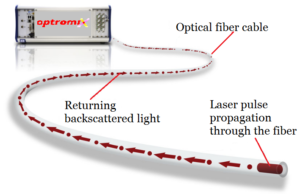 Traditionally, geothermal plants have been located in areas where hot springs and other indicators of thermal activity can be seen at the surface. However, enhanced geothermal systems (EGS) may also be used in areas where hot rock is found at reasonable depths. To achieve geothermal energy, fluid is injected into the drilled wells, heated by contact with the hot rock, and removed to power turbines at the surface. The majority of EGS utilize steam turbines to convert geothermal energy into electricity.
Traditionally, geothermal plants have been located in areas where hot springs and other indicators of thermal activity can be seen at the surface. However, enhanced geothermal systems (EGS) may also be used in areas where hot rock is found at reasonable depths. To achieve geothermal energy, fluid is injected into the drilled wells, heated by contact with the hot rock, and removed to power turbines at the surface. The majority of EGS utilize steam turbines to convert geothermal energy into electricity.
Under the constant pressures to lower operational costs and raise the effectiveness of the EGS, a number of parameters need to be managed to ensure high efficiency and competitive electricity prices. The efficiency of a geothermal plant is entirely reliant on the amount of steam that can be retrieved from the well, therefore, the subsurface reservoir must be able to provide quality geothermal fluid in sufficient quantities over its service life.
In order to retain the needed pressure in the well and to extend its service life, geothermal fluid achieved by hydraulically fracturing the hot rock is re-injected. Consequently, it is crucial to understand where the fluid is going inside the well and where the fluids come from.
It is well known and documented that the use of distributed temperature sensing in geothermal energy applications has greatly improved the reliability and longevity of EGS. Distributed temperature sensing systems can also be combined with other sensors, like FBG pressure sensors, to provide a complete data set. The information – subsurface temperature and pressure – can be used in various ways, such as:
1. Estimation of the production potential in the new wells be measuring the temperature at the point of pressure
The rate at which the fluid pressure drops after the operator opens the tap at the surface allows the calculations of reservoir size, flow resistance between wells, well completion, etc.
2. Monitoring of the surface and subsurface scale buildup and chemical cleanup
The buildup of scale – a mineral residue precipitated from the geothermal fluid – can inhibit fluid flow and block a pipe. A better understanding of the severity of the scaling may improve the choice of mitigating options.
3. Integrity monitoring for casing and tubing leaks.
The compromised integrity of the casing and tubing may lead to contamination of ground and subsurface aquifers.
An installed DTS system provides many additional monitoring opportunities. The efficiency of the geothermal plants may be greatly improved by combining temperature data with subsurface point pressure data. Distributed temperature sensing channels may be added to monitor surface processes. Another geothermal energy application of DTS systems in localization of overheated areas that allows mitigating the hotspots.
If you would like to purchase DTS (Distributed Temperature System), please contact us: info@optromix.com or +1 617 558 98 58
Fiber Bragg grating sensors in aerospace applications
 All engineering infrastructures undergo aging. The damage that appears over time is a consequence of the loads applied to them, therefore regular maintenance actions are required in order to predict the lifetime of these structures and lengthen it, which, in turn, will aid in avoiding catastrophic failures. Aviation-related infrastructures demand the highest levels of damage detection as these structures are overwhelmingly built according to a damage-tolerant principle. The structures for aerospace are designed to withstand damages with certain characteristics. Damage-tolerant design involves considerable effort for structure inspection. The inspections and maintenance tasks need to be periodic and scheduled; these are essential for safe and efficient operations.
All engineering infrastructures undergo aging. The damage that appears over time is a consequence of the loads applied to them, therefore regular maintenance actions are required in order to predict the lifetime of these structures and lengthen it, which, in turn, will aid in avoiding catastrophic failures. Aviation-related infrastructures demand the highest levels of damage detection as these structures are overwhelmingly built according to a damage-tolerant principle. The structures for aerospace are designed to withstand damages with certain characteristics. Damage-tolerant design involves considerable effort for structure inspection. The inspections and maintenance tasks need to be periodic and scheduled; these are essential for safe and efficient operations.
Automation of the inspection processes is a point of capital importance to reduce inspection efforts, as maintenance is time-consuming and costly. Fiber Bragg grating sensor systems can perform real-time inspection which leads to a reduction of maintenance costs and improved the reliability and performance of the structures. Therefore, there is great interest in developing FBG sensors from the industry and academia. The most promising sensors are FBG strain sensors, FBG temperature sensors, FBG accelerometers, etc.
The intrinsic capabilities of FBG sensors, such as insensitivity to electromagnetic radiation, lightweight, small size, high sensitivity and resolution, and, most importantly, their suitability to be embedded into structures, make them suitable for most aerospace applications.
Among different approaches to a maintenance system based on FBG sensors deployment are: 1) single-point sensors; 2) distributed sensing, including distributed temperature systems. Distributed temperature sensing (DTS) systems are optoelectronic devices that measure temperatures by means of optical fibers functioning as linear sensors. Temperatures are recorded along the optical sensor cable, thus not at points, but as a continuous profile. High accuracy of temperature determination is accomplished over great distances.
The successful application of FBG sensors to aircraft requires the sensors to provide reliable and accurate information about the condition of the structure and to reduce economic losses caused by unproductive downtimes. At this moment, FBG sensors and FBG based systems, such as DTS, are the most appropriate solution to most aerospace needs.
Optromix will write a tailored fiber Bragg grating-based on your specific requirements, which can be used with any type of optical fiber sensor technology. We will make sure to analyze your fiber optic applications and deliver the most suitable solution.
If you would like to purchase FBGs, please contact us: info@optromix.com or +1 617 558 9858
Fiber bragg grating sensors for structural health monitoring in harsh conditions
Piezoelectric transducers have been traditionally used in structural health monitoring. These devices convert pressure to an electric voltage. The transducers are typically reliable in normal working conditions, however, they become less accurate in harsh environments, like high temperatures – over 300 degrees Celsius – or highly corrosive environments.
With the development of laser technologies the popularity of fiber Bragg grating sensors have been increasing due to their numerous advantages over traditional means of measuring strain, pressure, and temperature: 1) FBG sensors work reliably under very high temperatures because of the optical fiber material – fused silica; 2) fiber Bragg grating sensors are immune to electromagnetic interference; 3) the sensors are not susceptible to corrosion; 4) FBG sensors are very small and can be easily mounted on any surface. The development of fiber-optics technology will enhance structural health monitoring in harsh conditions, such as nuclear power plants and modern superheaters.
The following types of FBG sensors are used in structural health monitoring:
The main advantages of fiber Bragg grating temperature sensors are their reliability and accuracy under high temperatures, absolute temperature measurements, fast response, immunity to electric sparks. The fast response rate is particularly useful in cases where temperature shifts are extreme.
FBG sensors are the best strain sensors at the moment due to multiple advantages that are inherent to all FBG products. These sensors can determine structure parts that are stressed.
Fiber Bragg grating displacement sensors can detect shifts in structures and the appearance of cracks.
There are many applications of fiber Bragg grating sensors for structural health monitoring. For example, one of the possible uses of FBG sensors is pipeline monitoring. P19 pipelines, that are used in the power industry, are usually used to transmit corrosive high-temperature, high-pressure steam. The integrity of the pipes may deteriorate over time leading to eventual failure of the steam transmitting system.
If you would like to purchase FBG (Fiber Bragg Gratings) sensors, please contact us: info@optromix.com or +1 617 558 98 58
Distributed temperature sensors in experimental hydrology
Distributed temperature sensors are usually used in industrial applications, such as process control and infrastructure monitoring; however, in the past couple of years, fiber optic distributed sensors have been used in ecological monitoring. The ability to measure temperature in time and space simultaneously allows distributed temperature sensors to be used in groundwater detection, rainforest ambient temperature monitoring, stream temperature monitoring, and more.
Temperature sensing is one of the most significant methods of experimental hydrology as it provides valuable insight into the flow dynamics of different types of water bodies. The water temperature is determined by measuring the Stokes/anti-Stokes ratio of reflected light that was produced by sending a laser pulse through the cable. The cable is placed into the body of water to detect temperature fluctuations along the stream. The data density of distributed sensors allows to obtain high-resolution data and map temperature changes in the water with high accuracy, and the absence of electronic parts in monitoring zones makes distributed sensors safe to use underwater. High return speeds of such optic sensors are perfect for both fast-changing and subtle temperature changes that often occur in water. Moreover, distributed temperature sensors are extremely thin and are easy to use in shallow streams and wells, and resistance to corrosion determines their long life cycle even if used in harsh conditions.
The measurements obtained by utilizing distributed temperature sensors are then used to construct 3D temperature maps of water streams or to validate and refine existing models of water temperature fluctuations. This data assists in finding locations of groundwater sources and their contribution to the stream helps to better understand river ecosystems, determine the distribution of studied species and their migration paths.
Other fields that utilize distributed temperature sensors include healthcare and biomedicine fields, fire detection, oil and gas production, detection of leakages, pipelines integrity surveillance, and others.
Optromix company manufactures stainless-steel housed optic sensors that are tensile and impact resistant. If you would like to purchase Optromix FBG Temperature Sensors, please contact us: info@optromix.com or +1 617 558 98 58.
Fiber Optic Temperature Monitoring of Belt Conveyors
Major conveyor belt–related mining incidents are now relatively infrequent as a result of recent improvements in engineering standards and the use of fire-resistant materials. However, conveyor belts are still a potential cause of personal and structural damage. In addition, any unexpected breakdown of rolling components or failure of belts creates a significant interruption to production, which is a major concern for operators, who are responsible for achieving optimum mining production. This project aimed to develop a fiber optic-based distributed temperature sensing (DTS) system to monitor the temperature change of malfunction idlers for heavy-duty conveyor belts in underground coal mines.
Conveyor belts have been widely used for centuries to transport general goods, bulk materials, and passengers. Conveyor belts have attained a dominant position in the continuous conveying of bulk materials ranging from very fine, dusty chemicals to bulk materials, such as raw ore and coal, as well as for overburden, including stones, soil, and logs of wood. In comparison to other transportation methods for bulk solids, such as trains or trucks, conveyor belts are an extremely favorable choice in instances where suitable infrastructures for other modes of transport do not exist.
The main fire risks associated with belt type conveyors are as follows:
› Friction due to loss of belt traction and slipping on the drive roller;
› Welding activities can generate hot molten material;
› Overheated materials placed on the belt;
› Build up of materials that have fallen off the belt and dust cloud generation;
› Static electricity.Continue reading
Distributed Temperature Sensing (DTS) system resolution
 The main idea of the Distributed Temperature Sensing is Raman-based temperature measurement joined with Optical Time-domain Reflectometry (OTDR). A short pulse of light is enabled into the fiber. The propagating light creates Raman backscattered light at two wavelengths, from all points along with the fiber. The wavelengths of the Raman backscattered light are different from that of the forward propagating light and are named “Stokes” or “anti-Stokes”.The amplitude of the Stokes light is not very dependent on temperature, while the amplitude of the anti-Stokes light is strongly dependent on temperature.
The main idea of the Distributed Temperature Sensing is Raman-based temperature measurement joined with Optical Time-domain Reflectometry (OTDR). A short pulse of light is enabled into the fiber. The propagating light creates Raman backscattered light at two wavelengths, from all points along with the fiber. The wavelengths of the Raman backscattered light are different from that of the forward propagating light and are named “Stokes” or “anti-Stokes”.The amplitude of the Stokes light is not very dependent on temperature, while the amplitude of the anti-Stokes light is strongly dependent on temperature.
A typically distributed sensing system is described by the spatial and temperature resolution. The spatial resolution is the minimum distance of the sensor to measure a step change in temperature along with the optical fiber. The temperature resolution is a measure of the precision to distinguish the absolute temperature. The temperature resolution depends on the measurement time and the launch pulse-recurrence rate. The laser pulse energy and duration are accurately controlled and optimized at the measurement maximum length to provide the best available temperature resolution within acceptable accuracy limits. As the sampling time is increased, the temperature resolution is improved and resolved temperatures become more accurate.
The report “Distributed Temperature Sensing (DTS) Market 2016 – 2023,” points out the key factors impacting the growth of this market and assesses its growth during the period between 2016 and 2023. Fiber optic sensing is challenging because the physical properties of light into the fiber are affected by strain, temperature, or sound. Several technologies enable local measurement – using sensors at chosen points along with the fiber (eg, fiber Bragg grating (FBG) technology for measuring localized pressure, strain, temperature, and flow) – or distributed sensing – with sensing occurring all along with the fiber.
Distributed sensing systems have been developed for the oil and gas industry to assist reservoir engineers in optimizing the well lifetime. Nowadays they find a wide variety of applications as integrity monitoring tools in process vessels, storage tanks, and piping systems offering the operator tools to schedule maintenance programs and maximize service life.
Optromix Company offers a Distributed fiber optic sensing system with high spatial and temporal profiling over large surfaces, long lengths, and at locations where conventional point sensing is not applicable or costs effective.
What is DTS?
A distributed temperature sensing system (DTS) is a device made to monitor power cable with fiber optic temperature sensors. DTS measures temperature on the large distances, greater than 30 km. It records the temperature along the cable as a continuous profile. DTS spatial resolution is 1 m with accuracy within ±1°C at a resolution of 0.01°C.
Adding RTTR to distributed temperature sensors allows achieving more precision when measuring high-temperature wire. DTS has some level of uncertainty when it detects the temperature, and its level increases when the conductor operates in an emergency situation. This happens because the conductor heating is detected with the time lag. Also, the temperature differs depending on the loading level. The higher the loading level is, the less precise are the measurements.
What is DTS measuring principle?
Certain factors, such as temperature or pressure, affect the optic cable and change the light transmission characteristics in the fiber. Optical fibers operate as linear temperature sensors when the light is projected in it through scattering to determine the location of the physical effect on the outside.
Optical fiber is made of doped quartz glass, silicon dioxide and has an amorphous solid structure. Its molecules interact with the photons when light falls on the thermally excited molecular oscillations. This process leads to light scattering, also called Raman scattering. The difference between the incident light and scattered light is that the later experiences a spectral shift that is equivalent to the lattice oscillation resonance frequency. The scattered light has three spectral shares, namely the Rayleigh (laser source wavelength scattering), the Stokes line components (lower frequency), and the anti-Stokes line components (higher frequency). Anti-stokes depend on the temperature, hence it is possible to calculate the fiber temperature as a ratio between anti-Stokes and Stokes line components.
What is DTS used for?
Distributed temperature sensing has multiple applications in different industrial segments to monitor power cables, tunnels, and industrial buildings, to detect leakages, and to control high-temperature wires. Recently DTS has been applied in monitoring ecological factors, such as groundwater, rainforests, river streams, etc.

